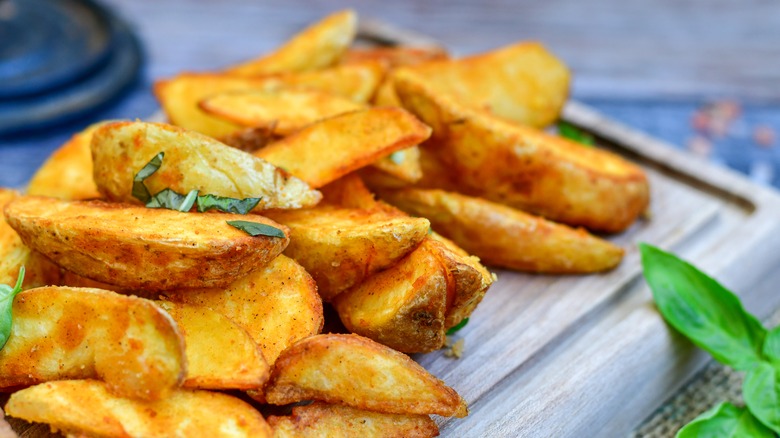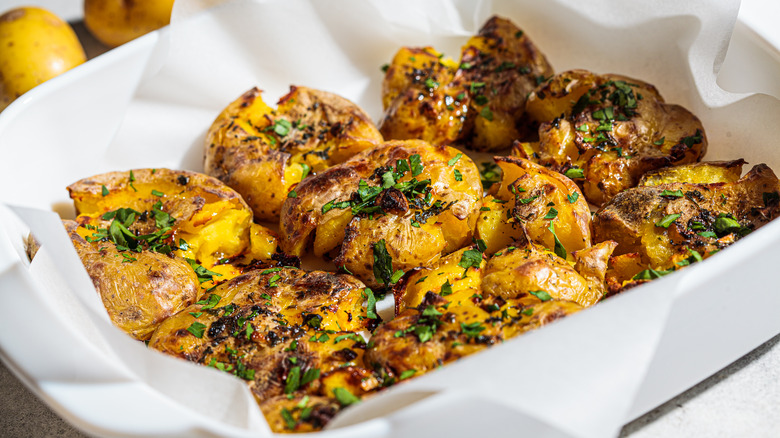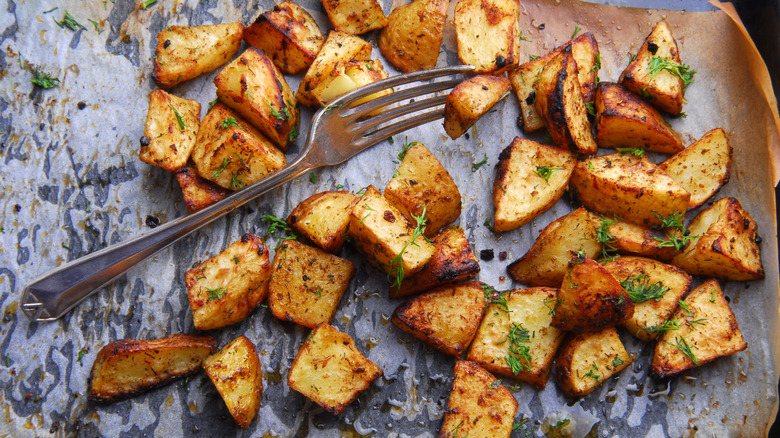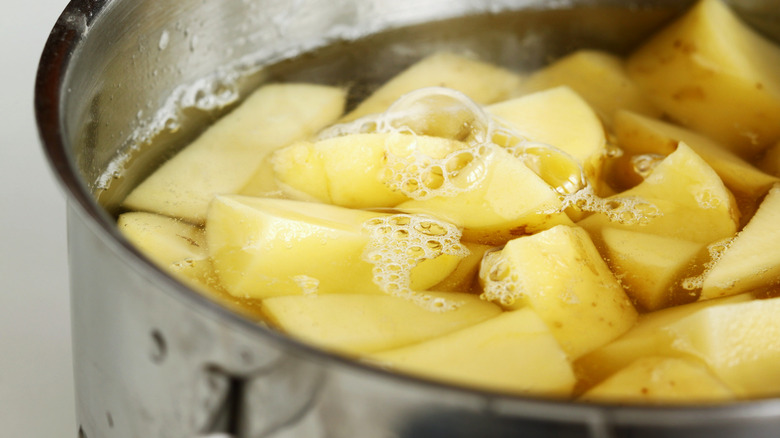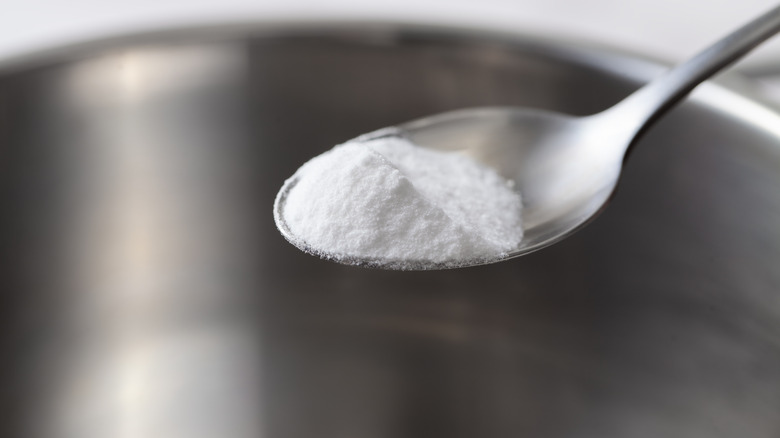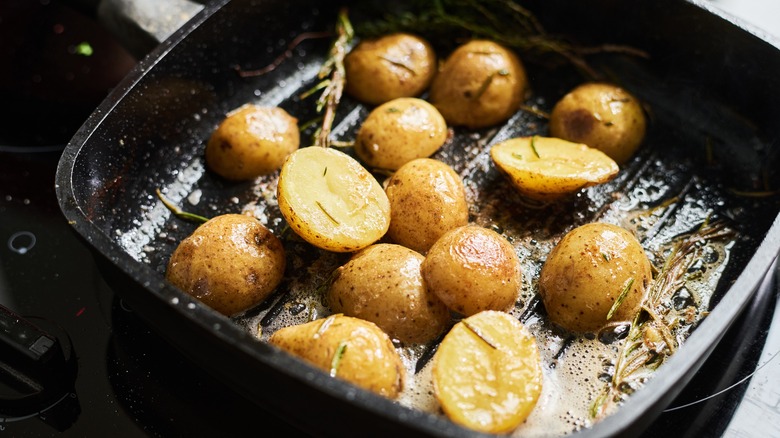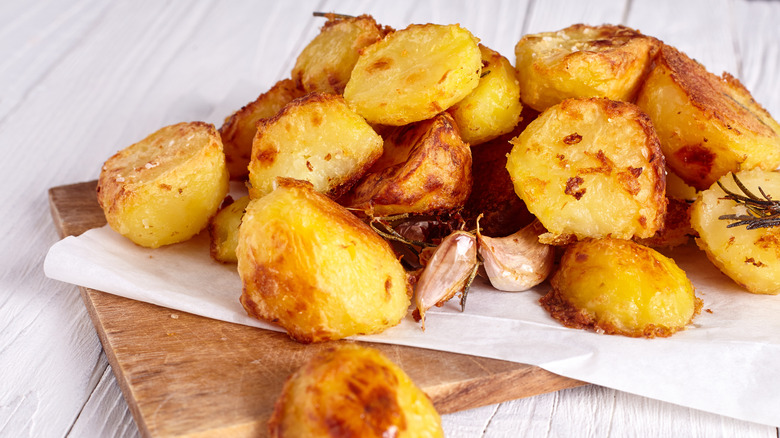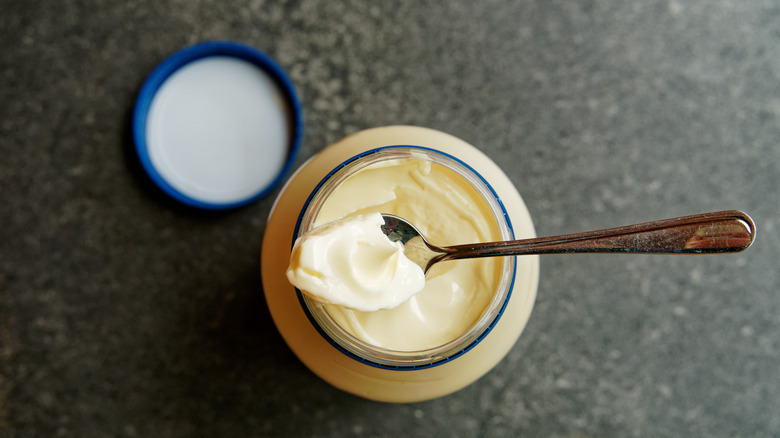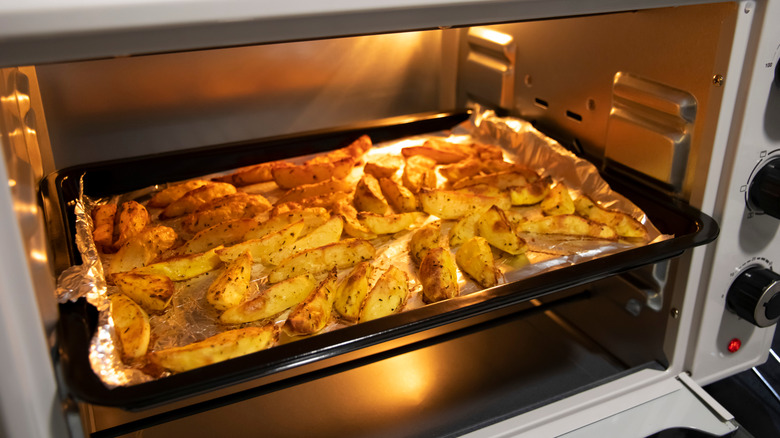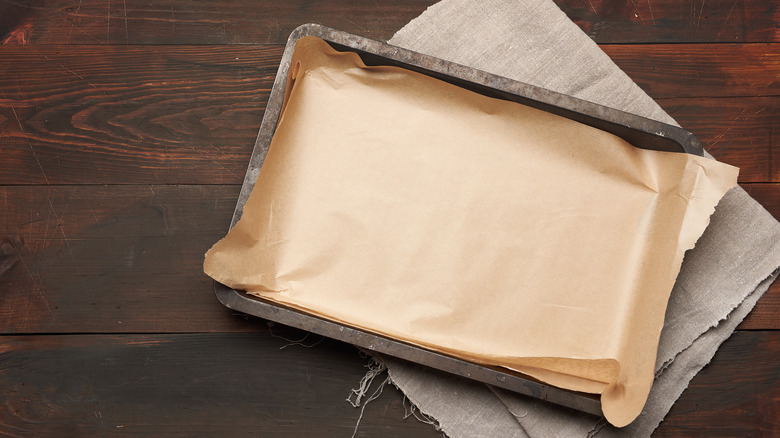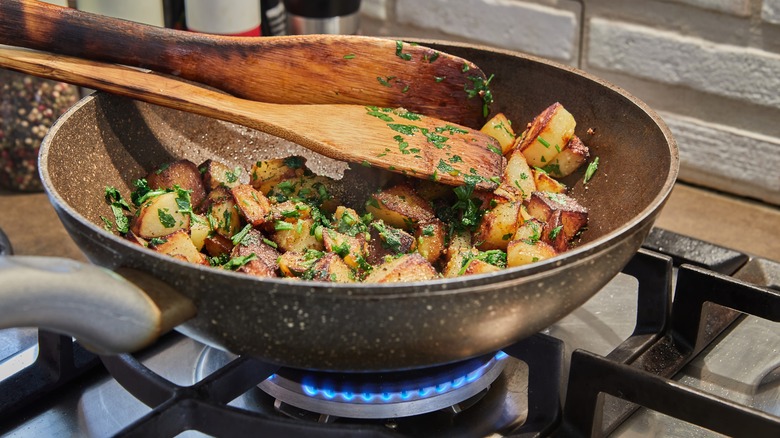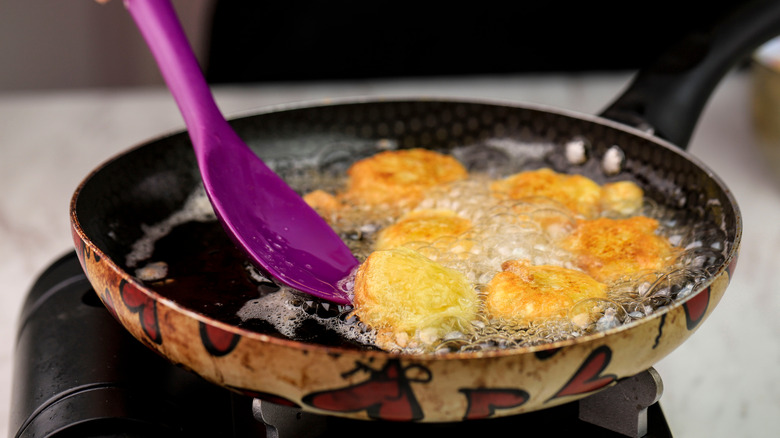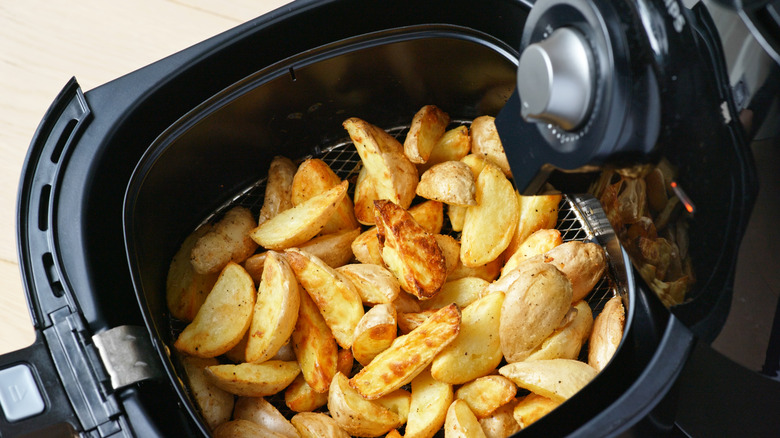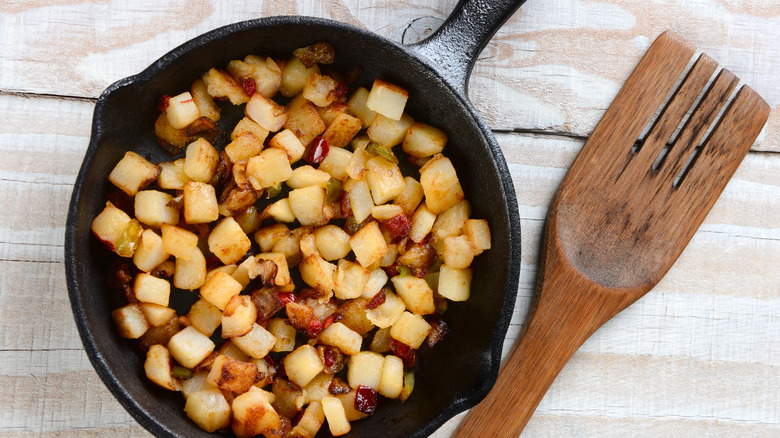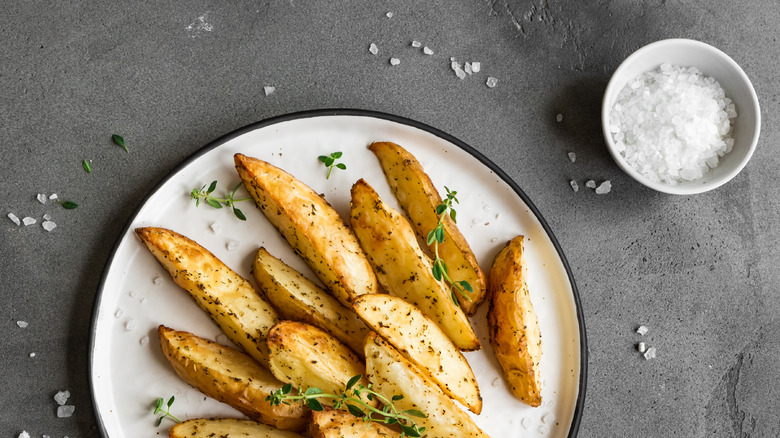15 Tips You Need To Get The Crispiest Potatoes
When it comes to classics, we can all agree that there's nothing better than a good old crispy potato whether they're in home fry, french fry, hash brown, chip, or smashed form. But how do restaurants get these spuds so unbelievably crispy? There are a few handy tricks that can help to ensure that your homemade skillet, fried, or baked potatoes won't leave you grabbing for a takeout menu.
Prepare to be the talk of your next Sunday brunch party or big game food fest, because once you put these hot tips to the test, there's no going back. The truth is that you don't eveen need a deep fryer to get that satisfying crunch of infamous that crispy outside coupled with the fluffy pillowy softness of the inside. Just prepare yourself for the never-ending influx of potato requests from your family now that you've unleashed your new skills. Let's get crisping!
Leave the skins on
Why peel your potato when you can enjoy an extra crunch of salty goodness? Just as you wouldn't remove the chicken skin from your favorite buffalo wing, it's best to leave your potato intact for that welcome added texture. There is nothing better than crispy, salty, baked skins loaded to the brim with delicious toppings.
If you've ever had the joy of experiencing smashed potatoes, then you know how delicious those skins can get. Crispy-edged smashed potatoes are simply small boiled potatoes, that have been smashed, oiled, seasoned, and roasted until crispy. Whatever the variety of potatoes, skins are a must-have because of their incredible texture. Even if you're dicing potatoes and readying them for baking or frying, leave those skins on. Beyond the flavor and texture boost, potato peeling can be the most laborious part of preparing spuds, so you just saved yourself a few extra minutes, and possibly a cut or two to the knuckles.
Cut the potatoes into large chunks
While those crunchy little bits at the bottom of your bag of fries are technically super crispy, they aren't always the most desirable little leftovers. Part of the appeal of a roasted or fried potato is the contrast between the fluffy, pillowy interior, and the crispy, crunchy exterior. Otherwise, we'd just reach for a bag of potato chips and call it a day.
To maximize the textural contrast, try cutting your potatoes into big enough chunks so that the soft insides have their moment of fame within each bite. Although you don't have to go as large as a steak fry, consider dicing potatoes no smaller than an inch in width. Each chunk should be a two-biter at most and have enough surface area to absorb the seasonings and crisp up really nicely. The majority of the flavor is going to come from the surface, so keep that in mind when choosing which shape you'd like to cut your spuds into.
And while we love a good toasty, crispy potato end, nobody wants to eat a full plate of tough crispy bits without any real potato. And hey, that means less chopping for you!
Parboil them first
One of the biggest mistakes people make with roasting potatoes is that they chop them up, toss them in oil, and throw them right into the oven. There is an extremely important step that needs to be taken before getting cooking to ensure that the inside is nice and fluffy and that the outside doesn't become tough. Because it's important to roast potatoes on high heat, consider parboiling them first so that the insides are cooked thoroughly and your oven can focus on crisping up the surface area. If this step is skipped, you may end up with leathery potato bites, with dense rubbery insides.
You can majorly elevate your roasted potatoes with this easy step. Simply chop your potatoes as you'd like, and let them cook in boiling water for a maximum of 10 minutes. (For smaller cuts, reduce the cooking time.) The outside of the potato should be soft, but not so much so that it crumbles away. The chunks should keep their form, but you may notice a starchy exterior forming on the surfaces. This exterior will be key to achieving that crispy, textured crunch that we crave.
Make the blanching water alkaline
We love a good starchy surface, and the best way to achieve that is not only by blanching your potatoes but also by also adding a secret ingredient to the boiling water. This simple step will take your roasted potatoes to the next level, and it takes very little time and effort to accomplish. While many people insist on adding salt to their boiling water, we are going to do you one better. Add about half a teaspoon of baking soda per two cups of water to your pot before allowing your potatoes to take the plunge.
Adding baking soda is a natural way to make your water more alkaline. This helps the exterior of the potatoes break down quicker and draws the starch to the surface, which leaves your potatoes with a starchy exterior, similar to the texture of mashed potatoes. This exterior is full of textured nooks and crannies that hold oil, and create their own crispy casing.
Fat is your friend
If you've opted out of frying your potatoes because you'd like to keep the fat to a minimum, keep in mind that for the ultimate crispiest potatoes you'll need at least a touch of the good stuff in the mix. It's important to coat your blanched potatoes with enough oil or fat to cover the surface. For low-temperature roasting, use olive oil. For high-temperature roasting and pan frying (which yields the best results) use animal fat, butter, or a high-temperature oil like peanut or canola. Animal fats will add an additional layer of flavor and depth to the potato but also contains cholesterol. If you opt for a vegetable-based oil, keep in mind that you can always infuse it with flavor using aromatics, spices, and herbs.
Fat increases the cooking temperature and also helps to dry out the surface of the potato, allowing it to react with the heat and become extra crispy. Even if you opt for an air fryer, consider using just a little bit of oil for the best-ever crispy potatoes.
Shake your potatoes
If you really want your potatoes to shine, consider roughing them up a little bit. For crispy results, try shaking your roast potatoes. This British method involves parboiling them so that the outsides are soft, drying them out, then putting them into a container with some kind of fat (bacon drippings or olive oil are prime candidates), and shaking them vigorously. This final step helps to break down the outside of the potato and creates a layer of starchy paste on the surface. The resulting little cracks add to the overall surface area and allow the fat to seep into the potato.
We have to agree with the British on this one, shaking is the way to go. The difference is quite noticeable with a clean-cut potato because you don't get those flakey bits that hold the most crunch. Whether you're roasting a batch for breakfast as a dinner side dish this small extra step can make all the difference.
Coat them in mayonnaise before baking
If you've already made the switch to buttering your sandwiches with mayonnaise rather than butter before grilling them, then this roasting tip should come as no surprise. You don't have to be from the Midwest to enjoy a good dollop of mayo on just about anything.
Skip the canola oil, you should slather your potatoes in mayonnaise before roasting them. Mayo has a similar effect as oil does on the surface of anything cooked at a high temperature, heating up the surface and drawing out moisture, leaving behind a to-die-for crispy outer layer. Mayo, however, has the advantage of providing an extra layer of flavor with the addition of eggs, mustard, salt, and vinegar. That tangy, rich mouthfeel is something that oil just doesn't bring to the table. And what better way to enjoy mayo baked potatoes than to dip them in more mayo?
Crank the heat up
If you can't take the heat, then get out of the kitchen. But seriously, when it comes to crisping potatoes in the oven, the hotter the better. Potatoes cooked at low heat will simply dry out and become pasty. The outside will never achieve that golden brown hue, or by the time it does, there will be very little potato left to enjoy.
While it's important to slow-roast meats, potatoes do not follow the same rule. This is one of those potato roasting hacks you may have wished you'd known sooner, because not only will the outcome be delicious, but it takes less time to make! The easier the better.
Just remember to parboil potatoes before roasting them. We want to give them a chance to start to cook before adding them to the oven. Be sure to preheat the oven to around 450 degrees Fahrenheit, then add your chopped, parboiled (then patted dry), and oiled potatoes. The insides will remain pillowy soft, and the outsides will become unimaginably crisp. You're welcome.
Preheat the baking pan
While it's quite obvious that preheating an oven is an important step when it comes to baking (after all, it is the first step to any recipe), there is something else that needs to be preheated as well. Adding a cold pan to a hot oven can cause warping, and slows the roasting process down. We don't want anything slowing down these spuds, and if they go in on a cold pan, it's putting a wrench in the process. Let's keep things hot, hot, hot from the very start.
Let that pan preheat along with the oven, and then be extra cautious when removing it from the oven to load it up with potatoes. Use parchment paper for an easy cleanup process, or roast them right on the surface. Don't worry about warped pans ever again, and enjoy potatoes that are just as crispy on the bottom as they are on top.
Leave the potatoes alone in the skillet or oven
When making pancakes, grilling burgers, or panfrying fish it can be so tempting to use your spatula to poke, prod, and stir ingredients around. Even though this might seem like the right thing to do, or let's face it, if you're bored and want to feel busy, you must refrain. Let your creation crisp, caramelize, and tenderize without intervention. Nothing more than a simple flip is needed, and the same goes for potatoes. This is why you need to stop bothering your poor roasted potatoes and let the oven do the work.
Feel free to give them a single flip at around the halfway mark or just leave them be altogether. By tossing them around too much, you risk ending up with unevenly cooked spuds, or worse, crumbly potatoes. Plus, when you frequently open the oven door you're letting precious heat escape, which may feel like a good idea on a chilly winter night, but won't do much good for your 'taters. That's why you want to keep the heat consistent. The same goes for skillet-roasted potatoes. Let them sit in that hot layer of oil, and flip them just once, only after the undersides are golden brown.
Deep fry them
Of course, we all know the very best way to achieve the crispiest potatoes on the planet is by deep frying them in a boiling vat of hot oil. And while not everyone owns a deep fryer, it's possible to get that oil bath going in a stovetop pot or pan. Hot oil is very dangerous, so wear the proper protective gear including gloves, long sleeves, and goggles. Be sure to use only high-temperature oils like vegetable and peanut to ensure the flavor of your potatoes isn't compromised.
Fill your pan with enough oil so that when you lower your potatoes in, they will be completely covered. Once you suspect the oil is hot enough, slowly lower a test potato into the depths to ensure that the oil reacts to it by bubbling vigorously. Use tongs to prevent splashing, and never use your bare hands. Let the potato float in the oil until it is crispy brown. If you must, use your tongs to flip the potato around to make sure it's evenly cooked. The potato will continue to fry even after it is removed from the pot, so time your removal accordingly. Place your crispy potatoes on a paper towel to remove excess oil, and then toss those chunks in salt and seasoning. Although this might not the healthiest option in the world, it sure is the crispiest.
Toss them in the air fryer
If deep frying isn't your thing but you love hot crispy foods, consider purchasing an air fryer. You should be air-frying your roasted potatoes because it's easy, energy efficient, and has the same incredible results as baking in just about half of the time. Air fryers use much less oil than pan frying and offer a much quicker cooking time than using a conventional oven. Roasting potatoes, a task that can sometimes up to an hour, typically takes less than 20 minutes in an air fryer. They are simple to use, easy to clean, and produce a crispy potato every time.
Before you toss your potatoes in the air fryer, cut and parboil them. Let them dry, add a little splash of fat, and then place the potatoes in your air fryer basket. About halfway through, remove the basket and shake it to help the potatoes shift around. This is the much easier equivalent of flipping each potato on a sheet pan mid-way through roasting. In less than the time it takes to watch a sitcom, you'll be ready to enjoy some crispy, lower-fat potatoes.
Pan fry the potatoes in hot oil
Brunch fans know all about the tastiness of a skillet-fried potato. There is just something different about that cast iron home fry that even a deep frier can't accomplish. Maybe it's the herbs, the butter, the onions, or perhaps it's simply the fact that cast iron can't be beaten. Consider chopping your potatoes, parboiling them, patting them dry, and then tossing them in a hot skillet. Let them sit without interruption in hot oil until they become crispy brown. These spuds should only be tampered with a few times throughout the cooking process, so keep your hands off unless necessary. Use a thin spatula to flip them over when the time comes. The beauty of cast iron is that after the spuds brown, you can always transfer them directly into the oven to finish cooking or to stay warm.
Take the opportunity of this open pan to throw in aromatics and make garlic herb skillet potatoes. Remember, the cooking oil should be at a hot temperature, so wait until the end to add delicate herbs or garlic. Onions can be added much sooner, but keep a close eye on them. Don't forget to finish with salt and pepper.
Salt them after cooking
Salt is an incredible preservative because it prevents bacterial growth by causing moisture to rise to the surface of meats and other foods. If you've ever used salt to sweat eggplant, then you know exactly what happens. Little beads of condensation accumulate on the surface of the vegetable, which then needs to be blotted with a paper towel. This is why you want to hold off on the salting until the end of the cooking process. If you salt potatoes before popping them into the oven, moisture will accumulate on the surface and prevent the outer layer from achieving full crispiness.
Instead, wait until the potatoes are fresh out of the oven to toss them in seasoning, including salt. The crystals will stick to the oils on the outside of the potato, and you can enjoy the incredible texture, along with the flavorful mouthfeel. After all, one of the best parts of eating a potato is the salty, satisfying crunch.
